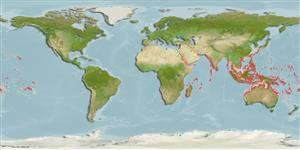Hexacorallia |
Scleractinia |
Faviidae
Environment: milieu / climate zone / depth range / distribution range
Ecology
Reef-associated; depth range 3 - 30 m (Ref. 8294). Tropical; 36°N - 34°S, 26°E - 137°W (Ref. 848)
Indo-Pacific.
Length at first maturity / Size / Weight / Age
Maturity: Lm ? range ? - ? cm Max length : 100.0 cm COLD male/unsexed; (Ref. 269)
This is the most commonly of several massive (mound-forming) species with a surface that resembles the maze-like pattern of a mammal brain. The valleys are typically 2 to 3 cm long and 0.5 to 0.6 cm wide. Colonies commonly grow to 1 m diameter or more and are found at all depths (Ref. 269).
Maximum depth from Ref. 98471. Colonies are found at all depths (Ref. 269). In most reef environments, especially found in back reef margins. Subtidal on rocks, rocky reefs, outer reef channel and lagoons (Ref. 98471). Dominant coral of the understory species on Acropora sp. patch reefs (Ref. 102838).
Life cycle and mating behavior
Maturity | Reproduction | Spawning | Eggs | Fecundity | Larvae
Hermaphroditic (Ref. 113712). Mature gametes are shed into the coelenteron and spawned through the mouth. Life cycle: The zygote develops into a planktonic planula larva. Metamorphosis begins with early morphogenesis of tentacles, septa and pharynx before larval settlement on the aboral end (Ref. 833).
Hodgson, G. 1998 Corals. p. 101-122. In Carpenter, K.E. and V.H. Niem (eds) FAO species identifidication guide for fishery purposes. The living marine resources of the Western Central Pacific. Vol. 1. Seaweeds, coral, bivalves and gastropods. FAO Rome. (Ref. 269)
IUCN Red List Status
(Ref. 130435: Version 2025-1)
CITES status (Ref. 108899)
Not Evaluated
Threat to humans
Human uses
| FishSource |
Tools
More information
Trophic EcologyFood items (preys)
Diet composition
Food consumption
Predators
Population dynamicsGrowthMax. ages / sizesLength-weight rel.Length-length rel.Length-frequenciesMass conversionAbundance PhysiologyOxygen consumption
Human RelatedStamps, coins, misc.
Internet sources
Estimates based on models
Preferred temperature
(Ref.
115969): 24.7 - 29.3, mean 28.4 (based on 3473 cells).
Fishing Vulnerability
High vulnerability (60 of 100).
Price category
Unknown.
